#religious modesty mindsets
Text





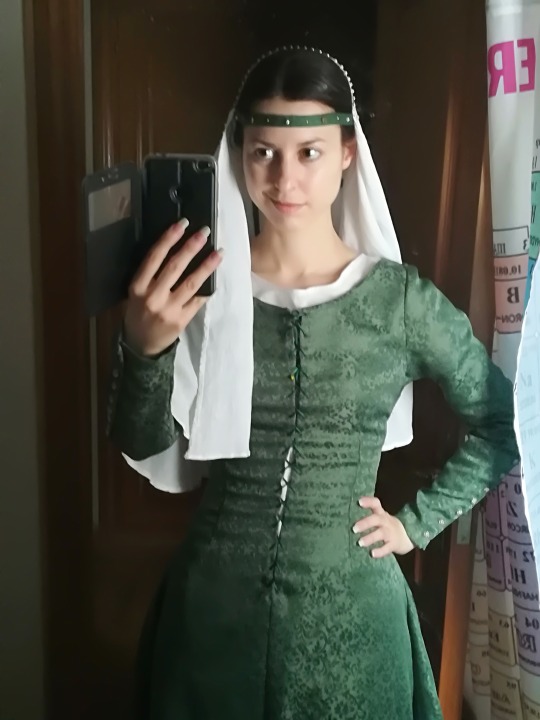

New additions for my late 14th-early 15th Century cotte outfit ⚜️! A pair of burgundy Medieval shoes and striped 'hose' from Armstreet ✨, and some tablet-weaving garters from @/emelunashop on Etsy ✨. I got it all in dark green and burgundy to fit the colour pattern of my damask cotte ensemble 💚💗
Also, some casual test pics (I since had the cotte slightly altered to remove a couple of front seams and give me more lacing allowance, and lowered the chemise's neckline as well to better fit the cotte), featuring the open hood and a couple of styles with the (faux) pearl-beaded linen veil. I have pretty much shied from the wimple styles in my Medieval reenactment so far because well, the baggage for female headwear is deeply steepled in religious patriarchy and gendered modesty mindsets, and that issue has always bugged me 😬. It can look interesting from a purely fashion standpoint, but yeah, it's hard for me to separate the two from a feminist pov. Still, I tried it very casually with a separate linen kerchief to see how it would look (minus the braids) 😅
14th Century reenactment
DeviantArt
FB cosplay page
IG cosplay page
#14th century#medieval reenactment#14th century reenactment#15th century#14th century fashion#15th century fashion#middle ages#medieval#medieval fashion#15th century reenactment#historical#historical fashion#historical reenactment#reenactment#reenactress#My reenactment#medieval hood#open hood#liripipe hood#cotte#cottehardie#historical costuming#medieval costume#medieval costuming#fillet#medieval headwear#medieval hairstyle#medieval women#medieval shoes#poulaines
6 notes
·
View notes
Text
LGBTQI+ rights in Niger 🇳🇪
LGBTQI+ persons face stigmatization among the broader population.Niger is predominantly a muslim country with conservative & traditionist mindsets.


LGBTQ+ pride flag of Niger
Legality of Homosexuality
Private consensual same sex relationship was legal in Niger until 2023.The age of consent was not equal for homosexual and heterosexual relationships.The age of consent is 13 for heterosexuals and 21 for homosexuals.Further Niger does not legally recognize same-sex unions.
Criminalization
In Niger homosexuality never been criminalized until 2023.In Colonie du Niger (Colony of Niger) from 1922 to 1960 there's no record of criminalization of homosexuality.Since 2023 president planning to criminalize homosexuality with a death penalty or life imprisonment.In October 2022,MP Nana Djoubie filed an anti homosexual bill to pave the way for the criminalization of homosexuality, as young lesbians prosecuted for indecent exposure,but could not be convicted under Nigerien laws.
Other laws may be used against LGBTQI+ members by police to discriminate them:
SECTION I - Outrage public decency (1993)
Art. 275: It is an outrage to public decency any material act contrary to morality committed in such a way that has been sighted or could be provided by third party whom he might offend the modesty.
Art. 276: Any person who has committed an outrage to public decency shall be punished with imprisonment between three months to three years and a fine of 10,000 to 100,000 francs.
Art. 277: It is an indecent assault lewd acts carried out directly on a person of one sex or the other.
Art. 278: Any indecent assault consummated or attempted without violence against a child of either sex under the age of thirteen years, shall be punished with imprisonment from two to ten years and a fine of 20,000 to 200,000 francs.
Art. 280: Anyone who committed an attack, consumed or attempted with violence, against individuals of one sex or the other, shall be punished with imprisonment from two to ten years and a fine of 20,000 to 200,000 francs.
SECTION III - Shameless acts with children of the same sex
Art. 282: Anyone who committed a lewd act against nature or with a person's same sex, child of twenty-one year, shall be punished with imprisonment from six months to three years and a fine of 10,000 to 100,000 francs.
Constitutional Rights or Civic Rights
Niger is predominantly muslim country.But Nigerien Constitution's Article 3 supports the separation of state & religion.Article 4 of prohibits discrimination & guarantees equality for All.In the Article 8 of Constitution assures all equality before law on the basis sex,social,ethnic or racial,religious status.But it does not includes the sexual orientation,gender identity or expression & sexual characteristics.
Public Opinion,Social Condition
There have been few cultural acceptances of gender vice versa & effeminates.It is said that effeminate people always been part of nigerien culture who organize traditional wedding ceremonies.
In Country Reports on Human Rights Practices 2016 by the US Department of State added that gay men & lesbians experienced societal discrimination and social resentment in Niger.That same report stated that due to societal pressure "many LGBTQI+ individuals married and had families, often while pursuing LGBTI relationships in secret."
According to Afrobarometer survey (2014-2016) 5.08% nigerien people can accept homosexuals as neighbors.Survey of 2016-2018 by Afrobarometer shows 8.5% nigerien people can accept homosexuals as neighbors.
In 2023, Mohamed Bazoum presented details of his plans for an anti-homosexuality law on a radio broadcast by public radio station La Voie du Sahel.He want to enact a strict laws for same sex love,same sex marriage & LGBTQ advocates in Niger.He also plans to bring death penalty for homosexuality in Niger.
Discrimination,Violence
Nigerien LGBTQI+ citizens experience legal and social challenges not experienced by non-LGBTQ+ people, for instance age of consent is not equalized for all,same sex unions are not legally acknowledged,trans people can't change their gender and LGBTQ+ people can't adopt a child.
There is no legal protection against discrimination based on sexual orientation or gender identity.The U.S. Department of State’s 2010 Human Rights Report found that “there were no reports of violence against individuals based on their sexual orientation or gender identity.According to the US Department of State's Country Reports 2016 stated that there were no known documented cases of LGBTQI discrimination in employment, occupation, housing, statelessness, access to education or health care.
Many NGOs including, UNHCR resettles many LGBTQ+ refugees in Niger.Further ILGA stated that the Nigerien Armed Forces do not prohibit gay,lesbian,bisexual or queer refugees from entering the country.
LGBTQI+ Association
There is no Public LGBTQIA+ rights org & no online support group in Niger.If they exist then they maintain anonymity for themselves.
Rainbow World Fund (RWF), a San Francisco based non-profit org. that promotes LGBTQ+ philanthropy for global relief & humanitarian service.In addition to helping people, the organization’s charitable efforts serve to build with other oppressed groups,to advocate for a greater global understanding of the LGBTQ community, & also to educate the LGBTQI community about world issues.The humanitarian goals of RWF are to eliminate oppression and suffering against queer people around the world.
Peace Corps, an international org served in more than 30 countries on programs involving prevention of HIV/AIDS,healthcare, education,disaster relief,humanitarian response,etc.LGBTQI+ RPCV provides opportunities for LGBTQ+ volunteers who willing to join Peace corp's humanitarian activities.
The Friends of Niger (FON) is a charitable,nonprofit corporation formed to promote development and humanitarian activities in Niger.This group is affiliated with National Peace Corps Association.
Recognition of Gender Identity
Niger does not recognize of any separate gender identity & people are not allowed to change their gender in legal documents,birth certificate,passport.
In some regions, effeminate males organizes traditional wedding ceremonies.Nigerien culture accepted such gender variances from the beginning.
Summary:
Same-sex sexual activity - ✔️/❌ [Ambiguous, illicit sexual relation or indecent sexual conduct with same sex may be punishable]
Equal age of consent - ❌
Recognition of same-sex marriage - ❌
Adoption by LGBTQI+ people - ❌
Anti-discrimination laws in hate speech and violence - ❌
Anti-discrimination laws in employment - ❌
Anti-discrimination laws in the provision of goods and services - ❌
Right to change legal gender - ❌
Third gender or non-binary option in legal documents - ❌
MSMs allowed to donate blood - ❌
2 notes
·
View notes
Text
Embracing Elegance: Exploring the Timeless Appeal of Apostolic Fashions
Introduction:
In the ever-evolving world of fashion, where trends come and go with each passing season, there exists a timeless and elegant style that transcends fleeting fads—Apostolic Fashions. Rooted in tradition, yet adaptable to modern sensibilities, this unique approach to dressing reflects a commitment to modesty, grace, and a profound connection to one's faith.
Understanding Apostolic Fashions:
Apostolic fashion is deeply influenced by religious beliefs, particularly within the Apostolic Pentecostal community. The emphasis is on modesty and humility, with clothing choices reflecting a commitment to dressing in a way that honors one's body as a temple. This style is not only a form of self-expression but also a tangible representation of spiritual values.

Modesty as a Statement:
In a world where skin-baring outfits often dominate the fashion scene, Apostolic Fashions stand out as a testament to the beauty of modesty. Long skirts, dresses with sleeves, and high necklines are common elements, allowing individuals to express their personal style while adhering to their religious principles. The commitment to modesty becomes a powerful statement, challenging societal norms and promoting a different standard of beauty.
Elegance in Simplicity:
Apostolic Fashions showcase the idea that simplicity can be incredibly elegant. Solid colors, subtle patterns, and timeless silhouettes create a wardrobe that transcends trends. The focus is on quality rather than quantity, with well-chosen pieces that withstand the test of time. This approach to fashion encourages a mindset of conscious consumption, where each garment is a meaningful addition to the wardrobe.
Adapting Tradition to Modernity:
While Apostolic Fashions are rooted in tradition, they are by no means stuck in the past. Many individuals adeptly blend traditional elements with contemporary trends, creating a style that is both timeless and relevant. Incorporating modern accessories, experimenting with fabrics, and exploring diverse color palettes allow for a creative fusion that speaks to the adaptability of this fashion ethos.

Building a Wardrobe with Purpose:
Apostolic Fashions prioritize intentionality in wardrobe choices. Each piece serves a purpose beyond mere aesthetics—it is a reflection of personal values, a commitment to faith, and an acknowledgment of the role clothing plays in shaping one's identity. Building a wardrobe with purpose goes hand in hand with the sustainability movement, encouraging a shift away from fast fashion towards thoughtful, enduring choices.
Conclusion:
Apostolic Fashions offer a refreshing perspective in the world of style—one that emphasizes modesty, elegance, and a deep connection to personal and religious values. In a society often driven by trends that change with the wind, this approach serves as a reminder that true style is timeless and transcends the constraints of passing fads. As fashion continues to evolve, Apostolic Fashions stand as a beacon of enduring grace and beauty.
1 note
·
View note
Link
(English below) Nuevo post en el blog! Pilar Erika y yo trabajamos en una traducción al quenya para la edición de invierno del 2020 de la Estel (nº 94, pp. 41-46), la revista de la Sociedad Tolkien Española (STE). Tradujimos unos fragmentos de uno de los poemas de Sor Juana Inés de la Cruz, la poeta y escritora mexicana del siglo XVII que se hizo monja para poder escribir, y que, a pesar de la sociedad tan patriarcal y jerárquica en la que le tocó vivir, era tanto una feminista subversiva como un ejemplo de persona LGBT+ histórica. Nos lo pasamos muy bien en este trabajo, ya que combina varios de nuestros temas favoritos: El feminismo y la visibilización de mujeres en la historia, Tolkien y los fandoms, las lenguas raras e inventadas, y la traducción . ................................................................................
New blog post! Back in 2020, fellow Tolkienite and feminist Pilar Erika and I worked on a Quenya translation which got published in the Winter 2020 edition of the Estel (no. 94), the biannual magazine of the Spanish Tolkien Society (Sociedad Tolkien Española, STE). We translated excerpts of one of the poems of Sor Juana Inés de la Cruz, a 17th Century Mexican nun who was also a subversive feminist and LGBT+ poetess and writer. We had a blast with this work, as it combines some of our favourite topics - feminism and herstory, Tolkien and fandoms, rare and invented languages, and translating .
#herstory#My essays and studies#My blog#feminism#poetesses#LGBT+#lesbian visibility#historical feminists#patriarchy#patriarchal modesty mindsets#religious modesty mindsets#(sor juana became a nun with the sole intention of being allowed to write and study as she didn't want to marry)#religion critical#badass historical women#historical lgbt+ people#hombres necios#juana inés#sor juana inés de la cruz#quenya#tolkien#translations#spanish tolkien society#estel#sor juana#17th century#mexican women#double standards#sor juana writing poems about the hypocrisy of men is a whole AESTHETIC#women writers#for those who say there weren't any feminists of lgbt+ people in history
1 note
·
View note
Text
I think that some social media feminists think that the “end goal” of feminism is not only to liberate women, but also to force every woman in the world to make the same decisions and have the same values as you. Like your takeaway from Right Wing Women was that you’re smarter than conservative or otherwise antifeminist women and you want to prevent them from making antiliberatory decisions
#women deserve the agency to make bad decisions because were human beings entitled to the dignity of free will#two contexts where I see this kind of mindset are discussions of domestic violence and discussions about head coverings/other religious and#cultural modesty wear
7 notes
·
View notes
Note
usually i dont like 'fixing art' but honestly i have to make an exception for you bc alot of this shit is just that (as a hijabi seeing that sexualization burqa killed the rest of my cognitive abilities)
like yeah, this is weirdly something ive been thinking about for the last few days. so you're going to have to put up with me rambling for a bit
for some context that most of you probably just dont have bc the last time i talke about it would probably be from over a year ago at this point, when i named this blog it was obviously based on Bad-comic-art's blog. and when i chose the url for this one i didn't think about how it would read to others. because like, the word "fix" never meant "make better" to me? it just meant "change". i think this is bc i grew up around a lot of people who spoke English as their second/third/fourth language, who were all trying very hard to make sure english was my first. so a lot of words that had wierd or imprecise translations got jumbled up in that mess, and fix was just one of them. that combined with my aphasia just made for the perfect time bomb of a url.
At first i just picked at which ever ones felt especially awkward to me, and then i started noticing trends that got me grinding my teeth. especially after a lot of people came forward to talk about how they felt better about themselves after the impossibility of the og arts proportions was pointed out. Because like, a lot of western comic art is meant to look fairly realistic, stylized, but still realistic, and that means that its a lot easier for our brains to internalize the proportions and ideals of theses styles as like, correct? as something that its worth comparing real skin and bone too without really realizing your doing it.
beyond that, ive always tried to focus more on things that were sexist. pieces where making sure a ladys tits and ass were center stage was more important than not snapping her back to do so. on sorta shining a light on how Weird a lot of these male comic artists were depicting women because them being sexy was more important than telling a story where they were characters.
and later once i had more context for some of the characters, and with a lot of help from my followers, i started being able to spot which ones were being whitewashed, and did a few of those edits too.
the dust one was very obviously an Issue that i didn't need explained but that one is still like, if i had to pick one piece to define what id want this blog to be, it would be that one. because it perfectly encompasses all my issues with a lot of comic art. Her being sexy was more important to that artist than her being a character with a specific religious background that wore a specific for of modesty garb bc thats what she wanted to wear.
and like mild tangent- this is why i try so hard to match the original as closely as possible. these styles arnt Bad usually. a lot of times they're just rushed, and doing edits to show what the artist could have done if they'd had the tims to do it always just felt like giving the original a second chance to shine? but some of the ways women and minorities especially are depicted, is just gross, and shows a clear sorta mindset. I want to match the originals in these cases to prove that the og artist, within their own style, could have depicted these characters with respect, but just chose not to.
beyond the edits i do that fall in the former categories, sometimes i just want to make people laugh so i do goofy things to art they dont like very much. thats always felt like sharpying a mustache on one historical figure or a other in a friends text book. just something harmless and fun to share in the back of the class room.
like i guess my tldr on this is this: bigotry is bad and i just want to make people happy by posting little edits on the internet.
#not a fix#anon#like i know i could change the url#but i kinda dont want to#it feels like covering up the past#anyways sorry for rambling#and yes#this is about that one drawfee bit
337 notes
·
View notes
Link
“Some of the world’s largest religions emerged during the Iron Age, and the rules in their sacred texts likely helped families and communities (or at least some subset) to thrive under Iron Age conditions. Today, we live under very different conditions. We know things our ancestors didn’t. We hold powers and face challenges they could not have imagined.
Here are a few of the moral mandates from the Abrahamic religions (Judaism, Christianity and Islam) that some people still practice on religious grounds but that a growing number of others consider morally dubious given our current circumstances and knowledge.
Hitting children—The Hebrew Bible instructs parents to beat their children, most explicitly in Proverbs 23: “Do not withhold discipline from a child; if you punish them with the rod, they will not die. Punish them with the rod and save them from death.” Traditional Muslim teachings exhort parents to beat boys if they don’t pray regularly by the age of seven.
Research in psychology contradicts this advice, pointing to few if any developmental benefits and an increased risk of aggression in children who are hit. Parenting experts suggest better means of raising children and managing misbehavior. Even religious leaders who may feel obliged to approve spanking because it is endorsed in their sacred texts (some of whom fiercely defend the god-given right of parents to hit their kids) now tend to send mixed messages and encourage other forms of discipline first.
Teaching children to rely on faith— Religions often treat faith or even religious certitude as a virtue. In fact, in Protestant Christianity it is the ultimate virtue, the one that sends people to heaven or hell. Believe and be saved, says the Christian New Testament, and one of the tenets of the Reformation was sola fide—by faith alone. Defenders of Christianity may marshal logic or evidence to support belief, but when backed into a corner, many default to I just know—and they teach children to do the same.
By contrast, modern cognitive science recognizes the sense of knowing as a feeling state that can be triggered under a wide variety of circumstances, not all of which have a basis in reality. Advocates for secularism argue that faith, by definition, means committing to a set of beliefs that are poorly grounded—or even contradict the best available evidence. We humans are prone to confirmation bias, for example, or self-serving “motivated” reasoning.
In belief-based religions like Christianity and Islam, doubt is seen as a sign of weakness or a moral failing, a sin. But knowing what we now know about human cognition, faith increasingly looks like a bad epistemology, a not-very-effective way of sifting what is real from what is not. By contrast, the scientific method has been called “What we know about how not to fool ourselves,” because it forces us to ask the questions that could show us wrong. Unlike faith in received dogma, the scientific method promotes a growth mindset. This is one reason that a growing number of people see religious indoctrination of children as an abuse of trust.
Restrictions on women’s movement and attire – Religious modesty and virginity rules for women emerged when a person’s place in society depended on paternal lineage. Women and men had no way of managing their fertility other than abstinence; and mama’s baby, papa’s maybe could create social havoc. Societies had a strong investment in controlling female fertility.
Modernity values people based on who they are, not on their lineage; and women now have reliable means to manage their fertility. Our life course need not be defined by the form of our genitalia. But male ownership of girls and women is so foundational in the Abrahamic traditions that conservative believers often find themselves most comfortable with gender hierarchy. Conservative Christians promote “male headship”—a version of separate-but-equal; conservative Muslims rationalize veiling—which (though it can mean different things to different believers) is rooted in male ownership of female sexuality; Orthodox Jews demand that women shave their heads and ride on separate sides of the bus.
Fortunately, although religions may slow cultural evolution, they rarely succeed in stopping it altogether. Even within conservative religious communities, leaders often claim that restrictive practices elevate women and offer them genuine equality. Their thinking may be Orwellian, but it is a far cry from that of the men who wrote the sacred texts, for whom male dominance and control of females was simply a given.
Pronatalism – “Be fruitful and multiply,” God tells man in the book of Genesis. Throughout the Bible, sons are seen as signs of God’s favor, the more the better. In the Christian New Testament book of 1 Timothy, readers are told that women, who brought sin into the world, will be saved by childbearing (2:15). The Roman Catholic Church, when it emerged, promoted a high birthrate—not among priests, which would have been a drain on church assets—but among lay practitioners, which added to the ranks of the faithful.
Today some devout Catholics and quiver-full Protestants (along with ultra-orthodox Jews and fundamentalist Muslims) still see bearing many children as a form of righteous submission to God’s will. They eschew family planning, taking a “let go and let God” approach to birth control. But as world population approaches eight billion, putting increasing pressure on natural resources and other species, many people now view large families the same way they might view gluttony. Most, including most religious believers, think it is more moral to take excellent care of a few children than to produce as many as possible.
Proselytizing mandates – Christianity tells believers to “make disciples of every creature,” and over the centuries Christians have sent missionaries to the far reaches of the planet, some willing to kill or die in order to win a “harvest” of converts. They have been celebrated as saints and martyrs, or in modern times as altruistic heroes. But many people now see cross-cultural proselytizing as a form of imperialism that disrespects the complexity of indigenous and foreign cultures.
To make matters more morally dubious, missionaries often leverage their superior access to information and wealth—enticing conversion by bundling evangelism with desperately-needed food, medical care, education or crisis services. To a missionary who sees the threat of hell as the ultimate risk and the promise of heaven as the ultimate good, the ends may justify the means; but outsiders see exploitation of power differentials, which most ethical codes discourage. Some countries now limit or constrain missionary activities to protect vulnerable communities and people.
Kosher slaughter rules – In the Torah, God commands that animals be slaughtered according to religious rules, and over time Jewish scholars fleshed these out. The animal is to have its throat slit with a very sharp knife that has no defects. It must be conscious at the time of the cut and must die from blood loss. These rules may have originally had health value for humans or animal welfare value for livestock, but with the availability of modern stunning, they have become controversial. Stunning animals immediately before slaughter can reduce suffering. Many Muslims think that Halal slaughter rules similarly prohibit stunning, but there is disagreement among Muslim scholars about this. Some animal welfare watchdog groups in Europe and the U.S. have advocated the banning of Kosher and Halal slaughter, while others are working to improve the practices in ways that reduce fear or suffering before and during slaughter.
Capital punishment – The human history of killing offenders goes back almost to the beginnings of written history. Death by axe, death by being thrown into a quagmire, death by beheading (which is where we get the term capital punishment), by boiling, by stoning . . . Over the millennia, all manner of death has been meted out for all manner of offences. The Hebrew Bible prescribes death for almost 30 transgressions ranging from murder and kidnapping to blasphemy and sassing, and the Quran is similarly enthusiastic about execution. (You can compare both texts here, or find out here if you deserve death according to the Bible.) Building on the Abrahamic tradition of blood atonement, the central premise of New Testament Christianity is structured around the idea that punishment by death can set things right.
For two hundred years, opponents of the death penalty have worked to reduce the number of capital offenses and the cruelty of execution methods or to advance philosophical and practical reasons for abolishing state-sanctioned killing altogether. Some of this opposition has been lead by devoutly religious people, and it has shifted thinking in a wide variety of cultures. Over 100 countries have abolished the death penalty.
Intolerance of other religions – In order to recruit and retain members, religions often make exclusive truth claims and promise exclusive rewards. Many also threaten those who fail to join or who choose to leave with punishments in this life or the next. Islam’s prescription of death for apostates is just an extreme version of this broader dynamic.
Inquisitions and holy wars have been seen by past generations as righteous because they compelled people to live according to the one right law. Even short of bloodshed, religious teachings can be profoundly divisive. Calvinist Christianity teaches that human beings are “utterly depraved” and can be redeemed only by accepting the crucifixion of Jesus as a personally-transforming gift. Believers learn to mistrust others, who by definition lack any basis for morality.
But this one-way mentality doesn’t seem as righteous to many as it once did. Today, when faith is compelled through holy war and purges—as under the Taliban or ISIS–most people are morally appalled, and people increasingly see religious tolerance as a virtue rather than the vice our ancestors believed it to be.
– – – – –
Some people believe that the moral rules handed down by our ancestors came from a supernatural deity and should not be questioned or changed. The gods know best, and even if their rules may not entirely make sense, ours is not to question why. In the Evangelical community where I grew up, people sometimes tried to find practical explanations for biblical rules. But when that failed, “because the Bible says so” was reason enough.
By contrast, secular ethics teach that the timeless part of morality is not the rules themselves, nor the authority of the rule-giver, but rather an underlying principle. Morality, in this view, seeks to promote the wellbeing of sentient beings, especially human beings but also other animals. Actions that reduce suffering and harm or increase wellbeing are moral. To maximize wellbeing, rules have to change, because what promotes thriving in one situation may cause harm in another...”
https://valerietarico.com/2018/07/22/when-religious-teachings-become-immoral/
Valerie Tarico is a psychologist and writer in Seattle, Washington.
10 notes
·
View notes
Text
THE JUDGMENTAL CHRISTIAN
By: Alicia Sarai
Blog: Simplilici.com
Disclaimer: I consider myself a follower of Christ, a Christian, a believer and any other title you may call me… NOTHING I say is to throw anyone under the bus or single out anyone.
I write this from experience, I write this because like many others I too have been singled out by a “judgmental person”.
It's funny that even though I am what my peers and society may label as a “Christian”. I have had other “Christians” slander my name, talk bad about me openly and even based on the length of my hair, “fleekness” of my makeup and the “oh.no its above the knee”length of my skirt draw their own conclusions on my personal walk with God, sexual orientation, and personality.
I am not saying that ONLY Christians judge, NOR am I in any way attacking anyone who self-identifies as a believer or a Child Of God..I am merely stating facts based on real-life circumstances that have allowed me to draw this conclusion.
Matthew 7:1-5
Judge NOT, that you be not judged. For with judgment you pronounce you will be judged, and with the measure you use it will be measured to you. Why do you see the speck that is in your brothers eye, BUT you do not notice the LOG that is in your own eye? or how can you say to your brother, ‘Let me take the speck out of your eye, when there is the log in your own eye? You hypocrite, first take out the log out of your own eye, and then you will see clearly to take the speck out of your brothers eye.
John 7:24-ESV
Do not judge by appearances, but judge with right judgment.
James 1:26
If anyone among you thinks he is religious, and does not bridle his tongue but deceives his own heart, this ones religion is useless.
John 3:17
For God did not send his son into the world to condemn the world , but that the world through HIM might be saved.
I could go on and on with biblical references on JUDGING… But I think my point has been taken.
While sitting in service one day the idea of this post came to mind. I thought about how many times WE as the body of Christ have run people out of the Christian faith based on our own personal God-FREE religious judgments. Its interesting to assume that God is speaking to us when we see that “unsaved” sister walk into church, her extensions fiery red, her skirt semi painted onto her flesh and her heels exceeding the 5 inch “holy ghost check” maximum and immediately assume her lifestyle, banking information, SIN card number, baby father number, sexual partners number and the list goes on.
One of the worst possible things that I have encountered in my 25 years on this planet we know as Earth is concluding something preposterous about someone with little to no information about anything concerning their daily life and personal walk with or without God. I hope I am not the first or the last to admit that I myself have played the role of the “Judgmental Christian”.
YES. I SAID IT. Shocking?
I have seen people in and out of church and made up in my mind that there was no way that person could have been a Child of God looking the way they did. With my Maxi Denim Skirt, elbow covering sweater and makeup-less face I concluded that anyone who looked a certain way could not be a reflection of Christ.
But where did that mindset come from?
I grew up believing that anyone who was not of the Apostolic denomination, wasn’t exactly “saved”. Why I thought this was beyond me but constantly hearing things said about certain people brainwashed me to think that Holiness was in long skirts, natural 4C curly hair and the good old Jamaican Tam that covered your hair not only on Sundays but at the occasional Wednesday Night Service and Youth Service on Fridays. Modesty was preached 24/7 at any and every Conference or Convention I attended. The “Sisters” were ridiculed for wearing their hair a certain way, skirt a certain length and for wearing “too much” makeup.
Being Holy, or being Christ Like was about my relationship yet I only ever heard stressing on clothes so you could imagine how that made me think and feel. I am not saying that being Modest is a bad thing, but when all the focus is on the outer appearance... where does God come in?
Maybe the snares and looks and comments I received as I got older were my Karma for all the years of being biased and ignorant. Maybe the Jezebel comments and cut eyes were Gods way of humbling me to show me how others may have felt when I myself turned a blind eye to them.
I would hear about girls who got pregnant at young ages.
I would think to myself how on earth could she even think about Sex? How as a Christian could she think its okay to let a guy do that to her, with her? I myself planning then that I would have my first REAL kiss when I was married.
(I kissed a few boys in Kindergarten and Grade 1)<- Doesn’t Count!
I was that girl that never gave in to guys comments, never gave in to the requests for dates and refused to let any guy so much as touch my hands too sensually.
God has a sense of humor I tell you.
I didn’t realize how anything could be possible until the rolls were reversed.
NO, I HAVE NOT EVER BEEN PREGNANT.
I knew sex before marriage was something I was told not to do since the day I was born. I swear. My parents never had the “birds and the bees” talk with my sister and I but it was something that they indirectly talked about with us. It was something they didn’t have to elaborate on.. we just knew.
That never stopped me though.
And it didn’t stop people from talking about me, from knowing my business and from gossiping about what I did.
“I heard Alicia had sex”
“I heard that at the... Alicia… and… were all having sex in the haystacks”
“I heard Alicia and… did...”
I had done the very thing I looked down on others for doing.
Now I realize that every life lesson makes you stronger and better and wiser. So that dark place in my life helped pave me into the woman I am today. People doubting me, giving up on me and writing me off because of my decisions only made me better and more determined to prove them wrong.
THANK GOD!
We have all been guilty of being judgmental, Christian or not. Many have had bad experiences with “church” people which have led them to stray away from churches on a whole or have a misconception of God without fully getting a taste of his essence. I am not preaching at all right now and do not want it to come across as If I am. I’m just an everyday girl who has experienced enough to validate my belief and trust in God.
I know how it feels to be looked down upon for not “waiting till marriage”, I know how it feels to have people assume the worst about you just because your skirt may accentuate certain body parts others may lack. I pierced my ears and was called a backslider, took a picture at the beach and had a “prayer meeting” called on my behalf, stood up for myself and been told I am rude and shaved and dyed my hair and been told I am a rebel. I know how it feels to not be someone and have people assume the worst.
Each day I strive to be open-minded without losing myself, to give others a chance and not conclude without knowledge. As Followers of Christ, we stress the small stuff, linger on the things that can be changed and write off people before even giving them a chance. God called us to love, he called us as the “church” to be forgiving, loving, honest and truthful. Kill them with kindness. Who are we to judge? We did NOT die for their sins, we are not God. And no I am not about to use the “Only God can Judge Me” line, I am just saying that unless we purpose in our heart to either help the people who need it the most then we have no rights to talk about them. Sometimes God sends the people you LEAST expect to have the most powerful and life-changing impacts on us.
In the Bible God used some of the most unique and unexpected people to deliver messages, preach his word and spread the Love of Jesus. Be careful who you look down on.
I've been typing for way too long and I want you guys to come back and read more of my posts so I am about to Shut up. But before I log off and finish watching Spider-Man (1994 Cartoon Version)…
God is Amazing and I am thankful that every day is a new journey for me, I’m striving daily to make God happy with my life, as hard as it may be. I am not perfect, there are moments I fall and cry but I make it my mission to get back up again and try again.
Don’t be like me. I was once, The Judgemental Christian.
#church#christian#christians#religion#religious#faith#hope#believe#live#learn#grow#growth#devotion#devotional#spiritual#inspiration#inspirational#self evaluation
16 notes
·
View notes
Text
Why is my religious mother so obsessed with my sex life? via /r/atheism
Submitted August 14, 2021 at 03:11PM by Mrsgurr
(Via reddit https://ift.tt/2XmRMt3)
Why is my religious mother so obsessed with my sex life?
I was raised as a Christian my whole life but I have decided to become atheist without my mothers knowledge. She gives me regular talks about how being a Christian is important in today’s society because of an increase in secularisation. I’m a virgin and she knows this but every time I have a conversation with her she somehow turns it into a sex talk. She said “A lot of girls these days think they own their bodies and can do whatever they like with it but you can’t”. Isn’t that the point of having your own body? The fact that you can do what you like with it. She always warns me about having sex before marriage and tells me that I can’t be a 'whore'. Bare in mind, I have never shown any interest in the opposite sex in front of her or shown any signs of hypersexuality. So why do I get this sex talk so regularly when I have never shown any interest in taking part in sexual activities?
I am 17 by the way so I am not a child and I feel as though she’s not actually looking out for me but she’s rather afraid of what other people will think. Her mindset and blatant misogyny makes me feel sick. It’s not even like she’s afraid I will end up as a teen mother, she is just so obsessed with my sex life and always says “please make sure that you keep your virginity”.
She is also obsessed with my body, the clothes I wear and where I go. I have had to resort to faking modesty whenever I go out so she won’t be suspicious of me. For example, when I leave the house I have to wear modest clothing so I will leave the houses in an oversized hoodie but when I meet my friends I remove it and wear the actual outfit I intended to wear. I now present myself to her in quite a hyper masculine way by wearing oversized clothing, boyfriend jeans and not wearing crop tops in front of her to throw her off. Some of this clothing isn’t really my style but I try to masculinise myself so I look evidently unattractive to the male gaze and yet she is still suspicious of me.
Why is she so obsessed with my non- existent sex life and what should I do about this?
P.S: my other is very narcissistic and uses her religion as an excuse to put down other women so no, she isn’t looking out for me at all.
0 notes
Text
Amish Culture: Work
Hello Everyone!
Welcome back to the blog that explores the Amish-American culture as it is compared to the mainstream American culture. In the first post, we compared Amish clothing to the mainstream clothing, in the second post we explored the Amish’s use of modern technology and compared it to how mainstream Americans use technology, and in the third, we explore the religious aspects of the Amish community and how it influences the way they live. Now, for this final post, we will dive into how people in the Amish culture work!
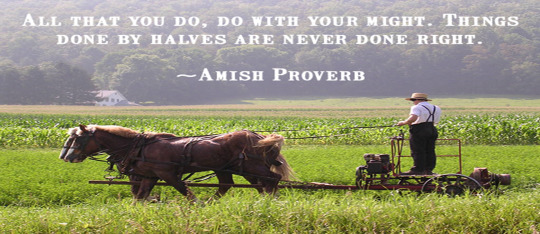
Jobs for Men:
Just like the everyday American, people in the Amish community work to make ends meet and to put food on the table for their families. The traditional preconception of work that the Amish are mostly known for is farming, just because it is hard work and the fact that they are known for their limited use of modern technology. They live out in the country lands doing their hard farm work, but along with farming, they also take care of and raise livestock, like cows, horses, and chickens. While farming, they grow a variety of things, which include corn, hay, wheat, soybeans, barley, potatoes, along with other vegetables and even tobacco.

However, the Amish community has had an increasing number of community members that have gotten involved in business enterprises and corporations. Even with this differentiating from farming, the business that the Amish community members are working for is mostly involved in the sale of carpentry or farming products. In relation to sales, people in the Amish community also work as auctioneers, which they sell any type of farm tools or even mud. So, as times have changed and the mindsets of people have, the Amish community has evolved to working in different areas of expertise without disrespecting and dishonoring their beliefs and values of humility and modesty within their religion or way of life.

An additional way that Amish people are working is through construction. They work with crews to build houses for Amish and non-Amish people, barns, churches, and other community buildings, along with fences and furniture. They use thick wood that is locally sourced in order to craft their furniture and other goods to last a long time. But, because of their values and ideals, they stay away from the modern power tools, so they have to get creative in how they make their goods. They use hang planes, saws, hammers, and chisels. The Amish do not use nails or screws, and they also use their own type of power tools, which are called pneumatic tools, which use compressed air and fuel-powered tools instead of the electric-powered ones.

Amish people also work with machines and car engines by repairing them, food stands, work in factories, and they also carry some unusual jobs. These jobs include casket makers, CNC technicians, strip miners, beekeepers, book rebinding, railroad work, granola manufacturer, and chiropractor.

Jobs for Women:
It is not just Amish men that get to work, Amish women work as well! The job that takes up most of their time is that of being a mother, but they also are tasked with running the household. So, they prepare meals, ready the home for church and other important social gatherings or situations, they plant and work in the garden, and they also can and process food. Those are jobs that do not pay actual money, but there are few women that work for money. Jobs that the women could work to make them money would be quilting, roadside stands with baking or other craft goods, and they can be nurses or nurse assistants. The men are seen as the primary earners in Amish homes.

Amish vs. Mainstream America:
Unlike the Amish, the mainstream American culture does not really fall into the gender roles or stereotype anymore that men are the primary earners, where they work and make all the money and the women stay home and take care of the children of the house. Women in this day and age can do anything a man can do and possibly even more. So, the mainstream American culture has men and women alike usually working everyday jobs that both men and women can do, and realistically, that can be any job that is available in the United States!

Motivation:
The way men do their work and why they work can be seen as extrinsic motivation because the men are working for money. They are motivated by that external reward to work and do a certain job. The women doing their certain jobs could be seen as intrinsic motivation, where they do their jobs for the sheer joy of working and doing their jobs, and not in it for the money. A specific type of intrinsic motivation for the women specifically could be public service motivation because the women take care of their children and their homes motivated by internal rewards and their sacrifice so much for their families and are compassionate. However, if the Amish women work for money, then it can be seen as extrinsic.
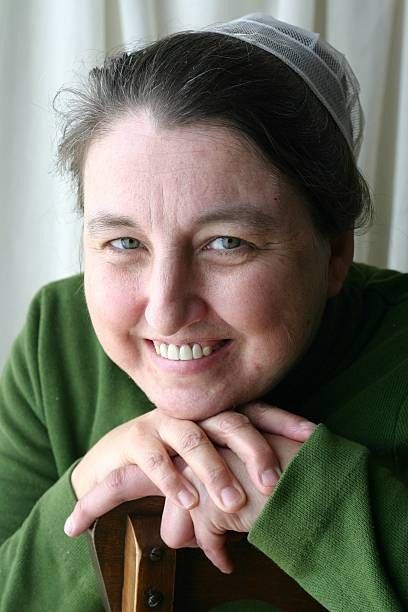
Thank you for reading!
Sources:
https://amishamerica.com/work/
https://www.familyhandyman.com/list/10-secrets-of-amish-furniture-makers/
https://lancasterpa.com/amish/amish-people/#:~:text=The%20Amish%20feel%20these%20distinctive,an%20expression%20of%20their%20faith.
https://www.laterlivingblog.com/amish-work/
https://www.usatoday.com/story/news/nation/2014/08/15/amish-ten-things-you-need-to-know/14111249/
0 notes
Text
Free the hair and seal the discrimination

For the longest time, veil has been such a controversial aspect of Muslim women’s lives which essentially brings up the question on whether veil is a tool for oppressing women or can it have other meaning as well. For generations, we see Muslim women are dressed a certain way and that is quite unique and indifferent to Western or majority Christian countries. There are some required dress codes and regulations that have been passed down from generations as well as through Islamic preachers and the Quran. Another aspect of Muslim women’s clothing is that it’s a personal choice for many, however, through most Westerners perspective, such regulations of women’s modest clothing reflect to something bad or negative which entitles to “Muslim women need saving” (The atlantic). While of course, an individual can choose to dress however they want, regardless of the religion. But, in Islam—modesty in clothing is tied with both men and women’s clothing attires advised by the Quran for reducing male gaze, comfort and to ensure the external embodiment of disciple and thereby reinforce the process of internalizing disciplinary practices (Mossiere,G). In spite of Muslim dress codes and regulations, Muslim women’s all around the world have taken a stance at changing the “Muslim clothing” into “Muslim Fashion” and these new females take advantage of the polysemy and flexibility of dress language to express various discourse about Islam (Geraldine Mossiere). The article also mentions “The dress codes that they adopt exemplify various combinations of these new Muslim feminist subjectivities, incorporating their religious identity as pious and veiled Muslim women as well as their position as modern and Western citizens” (Geraldine Mossiere).
Specially after the September 11 (9/11) 2001 terrorist attacks in New York, “the subsequent war on terror, veiled Muslim women received much attention from Western political, media and academics” (The conversation). Hence, Islam, hijab and facial features like beards became pollicised, hence associating them with terrorism and negativity. However, many Muslim women have taken on the social media platform to express their culture, personal choices while maintaining their religious status of being modest and pious to change the perspective of pro—created meaning of Islamic beauty as well as its clothing tradition. These same women are using fashion to express personal choice, exerting political influence as well a potential rebelliousness to the conservative style. Hence, “wearing these ethnic styles is not just a way to reclaim local aesthetic traditions—it can also be a way to express social or political critique by valorizing alternative sources of national pride” (The atlantic). Young Muslim women at present time, are utilizing social media platform like Facebook, Instagram as well as Pinterest to flaunt the Muslim clothing style as iconic and indifferent which also represent Hijab as a positive part of the daily attire. Infamous internet hashtags, such as; #hijabfashion #Hijabista aims to challenge the popular culture where Islamically is defined modesty and veil (the conversation). This challenges and movement changed the discourses about Muslimness and womanhood—also to represent how Muslim women are content with their Livelihood and how they are influencing their lifestyle while engaging and performing Islamic foundations and guidelines. These Muslim women have taken on the Internet to represent themselves as a fashion savvy consumer (the conversation).
To add onto that, Nurul Shamsul; who is the first veiled woman in New Zealand to participate in the Miss Universe New Zealand beauty pageant contest and she explains:

She uses social networks as a way of breaking the stereotypical norms regarding the binary view of the veil and Muslim Fashion. In many of these influencer’s posts, they represent stylish, colorful head scarves with body-wrapping suits/dresses as well as high heeled footwears. One of the important aspects of these influencers taking onto social media is that it changes the hegemonic views of Muslim women as powerless and excluded from social life which encourages many other Muslim women to be more involved and inspired as well. The article by Conversation also mentions that “Far from a binary categorization of the oppressed and the oppressor these phenomena signal a worlds in which Muslim women hybridise their faith and piety with modern ideas of feminism, activism and consumerism” which speaks for the idea that Muslim women have a choice too on however way they want to represent themselves, and that it does not necessarily mean they are oppressed or they require saving due to their indifference in clothing choices.
To also portray another positive aspect of the rising Muslim women’s statuses, Prime Minister of New Zealand, Jacinda Ardern’s decision to wear headscarf after the Christchurch mosque attack has also earned her a praise worldwide. Jacinda Ardern’s choice for wearing a headscarf has made many Muslim women feel safe to practise their faith in New Zealand and it showed mental support for many Muslim women that have suffered which is also a rare act of compassion from a non-Muslim person as well as from non-Muslim country. She also mentions on a Guardian article that “If in wearing the hijab as I did gave them a sense of security to continue to practise their faith, then I’m very pleased I did”—which shows the significant changed in mindset of some people in regards to Islam, Muslim women and their clothing choices to liberate those who practise their faith.
References:
1. Bucar, Elizabeth. “How Muslim Women Use Fashion To Exert Political Influence.” The Atlantic, Atlantic Media Company, 1 Feb. 2018, www.theatlantic.com/international/archive/2018/02/muslim-women-fashion-political-influence/550256/.
2. Mossière, G. Modesty and style in Islamic attire: Refashioning Muslim garments in a Western context. Cont Islam 6, 115–134 (2012). https://doi.org/10.1007/s11562-011-0180-9
3. Anoosh Soltani PhD candidate, and Hannah Thinyane Principal Research Fellow. “How Muslim Women Break Stereotypes by Mixing Faith and Modesty with Fashion.” The Conversation, 7 Sept. 2020, theconversation.com/how-muslim-women-break-stereotypes-by-mixing-faith-and-modesty-with-fashion-110767.
4. “As a Muslim Woman, I See the Veil as a Rejection of Progressive Values | Yasmin Alibhai-Brown.” The Guardian, Guardian News and Media, 20 Mar. 2015, www.theguardian.com/commentisfree/2015/mar/20/muslim-woman-veil-hijab.
0 notes
Text
Not pure
"You're pure like white snow..." his words echoed inside me and I felt like roaring loudly. It's definitely not the first time others' impressions of me sounds like a pink cotton candy. Pure, innocent, good girl, good woman, angel, soft...
I get it. I grew up in a religious world, in which my own urge to escape my feminine body found supportive excuses, via ideas such as purity, modesty, goodness, humility etc. For years, I've tried to escape my form through denial and hate, as well as spiritual mindset that dismiss the body. And I guess that it can still be felt to some degree, in the nuances of my manners and appearance.
But his comment opened a raging voice in me- "I'M NOT WILLING TO BE STRIPPED OF MY HUMANNESS!"
As I've been listening to that voice, in the last few months, I was able to understand that I'm wishing to be seen in all of my humanness. But what I can only do, is give myself exactly that. Keep allowing my flaws to exists without shame, keep exploring my own boundaries without guilt, keep diving into my own sexuality and sensuality with or without a partner, keep learning my desires, keep failing and rising, keep hurting and healing, keep on tending to my womb's pain; Keep on doing it all in my own pace, free of ideas of what's considered liberated enough, free enough, feminine enough, desirable enough, authentic enough or raw enough.
The upcoming holiday is called Shavuot, and its essence is the acceptance of the Tora. A wise teacher said "each organ inside me, which I accept, is an organ that the Tora can enters to...so in this time of holiday, take the time to go through each and every organ of yours and accept it".
To be a constant pink cotton candy isn't my desire. To be good, I acknowledge and willing to face the bad. To be soft, I acknowledge and willing to be rigid, to be sacred, I accept the body and her needs. (As for 'purity', this is a manipulative notion, which been used for centuries in patriarchal systems and religions, as a double edged sword, to control and degrade women and their bodies, so thanks but no!).
I'm human, I'm a woman, and each organ of mine is a wild animal.
And I don't mind if you're unable to see me fully, but I'll be damned if I'll miss out on my own fullness.
0 notes
Text
My Influences


As multiculturalism is a symbolic term used to portray Canada, the interaction of various cultures that coexist within its communities have influenced it to be a cultural mosaic society. Being a first generation immigrant to Canada has reinforced the significance of incorporating social norms of Western and Middle Eastern culture as well as experiencing the various cultures that are integrated into Canadian society. Although I identify as a Palestinian Jordanian Canadian citizen, the ethnocultural diversity that prevails within my community has influenced my cultural identity through adopting various foods, fashion, architecture, leisure activities, and entertainment. As an immense lover of food, various cuisines have given me the opportunity to explore exotic, rich and flavourful dishes from all over the world.
One of the many advantages of living within a diverse community is the abundant and rich flavourful cuisines that are offered. The increase of immigrants and diverse ethnocultural minorities in London Ontario brought upon the integration of Asian, Middle Eastern, Indo - Asian, and Spanish food. Although some restaurants alter the process of cooking particular foods to assimilate it into food that is favourable by Western Culture, ingredients that are used to compose a main foreign dish are usually maintained. For instance, Qdoba is a westernized Mexican inspired fast food restaurant that I occasionally visit to enjoy one of my most preferred cuisines, it offers a variety of deeply desired Mexican salsas such as Guacamole and Pico de Gallo. Guacamole is a salsa that was originally made by the Aztecs due to its main ingredient, avocado, originating in Central America and eventually introduced to North Mexico (Food History: guacamole and the avocado, 2015) . Pico de Gallo is a colourful and rich vegan salsa referred to as Salsa Bandera (flag salsa) because its ingredients resemble the colours of the Mexican Flag (Trapella, 2018). Due to my Palestinian-Jordanian heritage, Middle Eastern cuisine is mainly incorporated into my daily meal planning routine. The traditional Jordanian dish, Mansaf, is the main meal that consumed at special events such as weddings, engagements, and funerals. Mansaf originates from Jordanian Bedouins and is prepared by placing a layer of shrak or markook bread, rice layered on the bread, topped with lamb meat and Jameed (sour yogourt), and garnished with pine nuts as well as almonds. Since Palestinian and Jordanian cultures are very identical, Mansaf is a prominent Palestinian dish as well. However, natively made and proudly served by Palestinians for many years is the Maskan. Growing up, Maskhan was made two to three times per month. It is served with Lavash or naan bread at the bottom with seasoned chicken sautéed onions along with sumac, and garnished with nuts. Overall, the food I consume on a regular basis is due to the multicultural influence that impacts and generates a diverse environment in Canada. As food is a very critical aspect of culture, fashion is used by many cultures as an identity verification to be recognized by belonging to a certain culture or faith.

Traditional Jordanian dish, Mansaf.
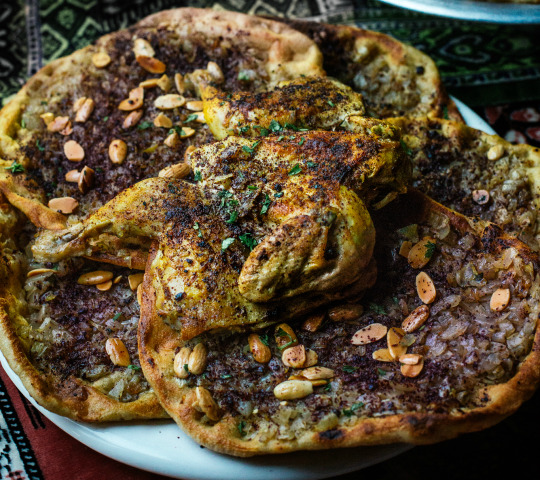
The traditional Palestinian dish, Masakhan.
As faith presents a critical role in my life, fashion is tremendously by the guidelines of my religion, Islam. Modesty is deeply valued in Islam and is highly expected to be displayed through clothing, interaction and behaviour. At the age of thirteen years old, I made the important decision to wear my hijab, a head scarf, that fully covers the hair. The hijab is usually worn as a symbol in Islam that portrays devotion to Allah (God). As hijab has been incorporated into my life on a regular basis, I view and value it to be a sense of lifestyle that signifies my identity of belonging to Islam. However, modesty is not only portrayed by the headscarf, it includes dressing in modest fashion that does not display the body shape of a woman or a man. This form of modest dress code in Islam was granted to Muslim women and men as a form of showing respect to their bodies and interacting with each other on a basis of respect rather than physical attraction. Modesty is also a form of respect portrayed to God when an individual seeks to prove that they acquire the moral strength to gain control over their desires rather than comply to them. Moral strength is not only demonstrated through modesty in fashion, it is also demonstrated through patience, maintaining positive character when encountered by negative character, and through a respectful form of speech. As modesty portrayed through fashion is an aspect of identifying to a particular faith, architecture is also considered to be a significant aspect of religion because it reflects the place of worship, valued symbols or structures of a certain faith.
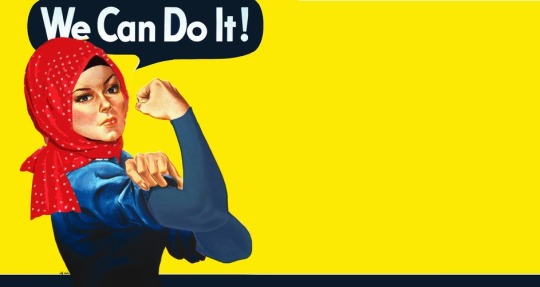
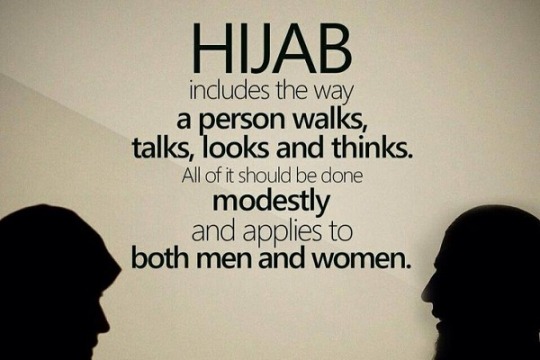
In Islam, the place of worship for Muslims is the Mosque, they attend prayers, read the holy Quran as well as attend religious speeches. Although attending the mosque during certain religious holidays is considered to be a sacred practice, visiting a local Mosque regularly is still a significant practice for Muslims. In London Ontario, I was raised to occasionally attend prayers at the local mosque, London Muslim Mosque. Rituals participated in at the mosque include reading the Holy Quran, praying, and interacting with members of the Muslim community. Attending the Mosque during Islamic holidays such as Eid Al Adha, Eid Al Fitr and during the Holy month of Ramadan. However, the two most sacred temples for Muslims are Masjid Al Aqsa (Al Aqsa Mosque) and Holy Mecca. Masjid Al Aqsa located in Jerusalem, Palestine is a historical mosque that was visited by many prophets who intended to spread the message of monotheism. Muslims all over the world intend to visit Masjid Al Aqsa since prayers are accounted more significantly when performed there. The holy site, Mecca, is the sacred area that Muslims set on pilgrimage to fulfill an obligatory duty, repent for their sins and interact with other Muslims. The holy site of Mecca is located in Saudi Arabia and it is the place of birth of the beloved prophet Muhammad, founder of Islam. He is the prophet and messenger of the last religion (Islam) sent down to the inhabitants of the Earth by God. Aside from valuing religious holy sites, I behold a tremendous amount of value for cherished symbolic Canadian architecture such as the CN tower located in Toronto. The history of the Canadian National Tower (CIN Tower), built by a Canadian architect John Andrews in 1968, was intended to serve the greater Toronto area with radio and television communication, constructed in order to portray the success of the Canadian industry (The History Of Toronto’s CN Tower In 1 Minute, 2016) . Toronto being the largest city in Canada, it offers multiple tourist attraction sites within various locations ranging from its bustling city streets to its adventurous Toronto Island located a few minutes offshore from the city centre. Another significant touristic site in Toronto is Casa Loma. Casa Loma is an immense mansion that is located in Toronto and previously owned and built by Sir Henry and Lady Pellatt. Sir Henry Pellatt was a contributing member to Canadian society during his time due to the fact that he was a successful financier, industrialist, and high ranking military officer. The enchanting mansion holds within it bone chilling ghost stories and a secretly hid Canadian military laboratory which involved the location of a military device, ASDIC device, used to track German U - boats during the World War II (Sen Nag, 2016). Overall, the significance I value for particular architectural structures is majorly influenced by my faith, Islam, and the country I currently live in, Canada. Brought upon valuable architectural structures are sites for leisure and entertainment purposes.

Al Aqsa Mosque in Jerusalem, Palestine.
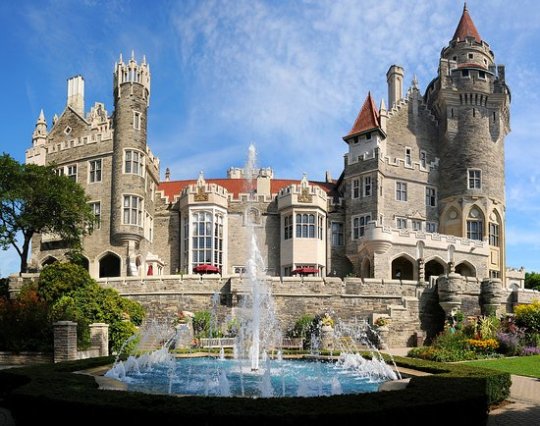
Casa Loma in Toronto, Canada.
The diverse cultures in London and areas surrounding London such as Toronto have influenced the integration of diverse entertainment businesses. For instance, hookah lounges are common entertainment businesses for Middle Eastern cultures. The hookah originated in the form of a coconut shell in India and developed a cultural approach in Turkey. Also, Iran adopted the shisha and contributed to its global popularity. Growing up, leisure activities that are available depend on the season. During the summer, activities I engage in mainly include camping and hiking. Camping originates from a tradition in the United Kingdom, as it was first practiced by Thomas Hiram Holding (Williams, 2014). He wrote the first camping handbook in 1908 based on his journey travelling through the prairies in America. Hiking during the Summer, Spring and Fall is an activity that I annually participate in during these seasons. Recreational activities have profoundly been influenced by the Western culture due to the grassy and mountainous landscape of Canada that call out for adventure and set the appropriate environment to hike in various areas. During the Winter season, my sister and I go sledding at a hill near our home. Sleds originated from ancient cultures, using them as a form of transportation to transport materials from one place to another during labour. Entertainment activities have been more so influenced by culture rather than Faith.
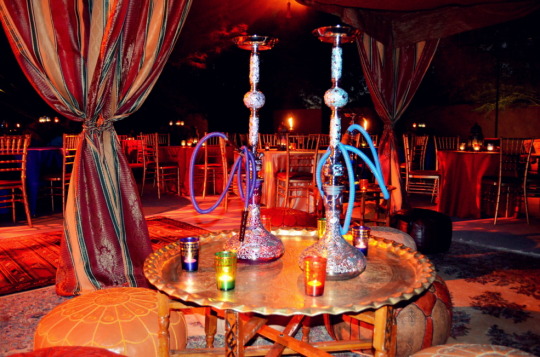
To conclude, faith has a tremendous impact on my cultural identity. Although, I do take a significant amount of pride being a Palestinian Jordanian and Canadian citizen, Islam has profoundly guided me to implement the morals and personal strength to achieve a successful way of life through setting a dedicated mindset by believing that a higher power such as God has a plan for me. Overall, the influences behind my cultural identity include my religious beliefs, values of westernized and Middle Eastern culture, both immersed together contributing to a cohesive whole.
0 notes
Text
Fundamentalist Mormonism
https://www.nbcnews.com/news/us-news/fundamentalist-mormon-town-modernization-highlights-stark-divide-n948281
The small town of Colorado City in Arizona begins to see a new era as a new mayor takes office. The long-time control of the town by a court-appointed monitor has officially been handed to the town’s first non-fundamentalist female mayor. Donia Jessop, a former member of the Fundamentalist Church of Jesus Christ of Latter-Day Saints, looks to open up her new community to the world after years of it being previously closed off.
For the first test, we learned about Mormonism and the outlawed practice of Polygamy. An interesting part about this town is its practice of multiple marriages. Polygamy first became an important part of Mormon religion and culture when the LDS Church founder Joseph Smith had a revelation in 1843 that would introduce polygamy to the world. Smith believed that in order for women to reach salvation they needed to be married; he saw that it was his and others’ duty to marry multiple women to ensure their salvation. Smith encouraged those that were deemed worthy to choose multiple women as their brides to ensure their lives would continue in heaven with God after their lives on Earth were over. However, polygamy was not readily accepted by other religious Americans. In 1844, Joseph Smith was murdered by a mob of his past followers who no longer agreed with Smith’s new ideas for the LDS Church. The practice of polygamy continued until 1890 when Mormon President Wilford Woodruff deemed it illegal. Those who continued to practice it and other strict laws of the LDS Church would become known as Fundamentalist Mormons.
Colorado City saw the strict fundamentalist side of Mormonism during its time under Warren Jeffs. Women were encouraged to cover themselves from head to toe to protect their modesty, video games and certain books were banned, fences were built around homes to have privacy and roads were left unpaved. In late 2018, Mayor Donia Jessop started to implement modern day advances to the town, including a vape shop and a subway which would never had been seen previously. As the town becomes modernized and more non-fundamentalists begin to settle in a question begins to rise, what will become of the those who continue to follow the practices of the FLDS Church? If they continue their strict practices, they could become outsiders in their own town, but if they shun their long-held practices will they lose a bit of their faith? It makes me think about how America is supposed to be a place of religious freedom. Despite there being a great amount of different religions practiced in the United States, it seems that anything outside of the “norm” Christian values is deemed unworthy or barbaric, such as the practice of polygamy. Although not everyone has this type of mindset, there are quite a few followers of religion that believe what others do is not right and continue to look down on them for it instead of letting them be. Although the practice of polygamy is a foreign concept to me, the practice does not personally affect me so I do not feel the need to hate another person for partaking in it.
0 notes
Text
Display Elegance and Style by Wearing Modest Hoodie Abaya Dress
When it comes to women’s fashion, what she wishes to wear should be her prerogative. While progressive societies have always promoted this standard, the situation isn’t the same in conservative societies where women are bound by religious principles and cultural sentiments. Muslim women across the globe have to abide by Islamic rules and regulations when it comes to clothing. One of the most important elements that people from Muslim community especially women need to bear in mind is modesty, which certainly limits their fashion choices.
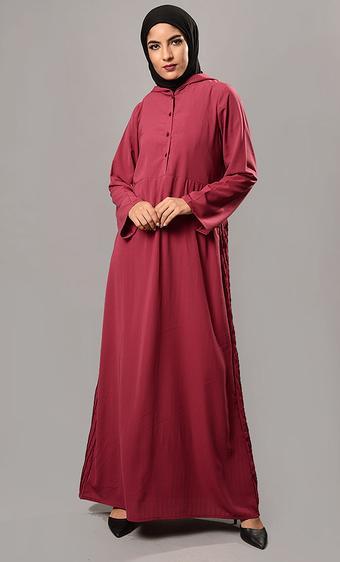
However, over the years the industry mindset has changed for good with fashion retailers and brands venturing into this otherwise cornered segment by offering wide range of Islamic wears for men, women and children alike. The best part of these clothing range are the contemporary designs that clearly reflects, as well as preserves the Islamic heritage with a touch of modernity. In other words, these fashion wears are designed to fulfill the desire of Muslim women to look fashionable without compromising on modesty.
One such fashion attire that offers a perfect blend of style and modesty is a Hoodie Abaya dress. Since, Islamic fashion wears are also offered by online retailers, one could purchase a Hoodie Abaya Dress Online. As a leading online retailer of Islamic clothing, East Essence offers wide range of modest fashion wears at affordable prices. Based out in the U.S, the clothing retailer caters to the cultural and aesthetic needs of new generation Muslims based out in the west.
So, if you are a Muslim woman looking out for Jersey Abaya Dresses Online or any other Abaya dress, you have the option to choose from wide range of color, fabric and design options. Apart from the Muslim community, these stylish yet modest wears have also attracted customers from the non-Muslim community, who have now started respecting the Muslim faith of modest dressing without sacrificing style.
0 notes
Note
I have a problem with SM's idea of perfection. In the Vampire Chronicles, by Anne Rice, the vampire's personal beauty, both inner and outer, was enhanced, not changed. Even "ugly" people were deemed as beautiful because their inner beauty was enhanced by Amel's powers. But they didn't change, they were just enhanced into the most perfect them they could be. This is why Magnus has missing teeth still. I think THAT idea of perfection is better than Meyer's. With hers everyone loses their self.
I think SM’s ideas of the creepily perfect re-making of people when they become a vampire has a lot of potential but only if you really go there and explore what it’s like to sort of lose a lot of what you recognized as yourself. No more eye color, no more freckles, no more beauty marks, no more scars, no more piercings, no more tattoos. . . all of those things add up to make people unique. And then you have the perfection of the features, everything perfect and smooth and symmetrical. It has to be so disorienting, and probably frightening, to see your face for the first time as a vampire. Not just the bright red eyes, but the fact that all the things that made you, you are gone, that your face has been “perfected.” I sort of think of it as like a talented artist doing a sculpture of you, but they flatter you too much. Like, it looks like you, kind of, but it’s so perfect that there’s something off and alien about it. Bella has that moment of being uneasy with her reflection, but it’s focused mainly on the eyes and she also experiences “unthinking pleasure,” I think was the word. Likewise SM writes that Rosalie felt better when she saw how beautiful she was. I don’t know if most people really work that way, though? There are stories of people who get facial reconstruction after an accident and then freak out when they see themselves, not because they look worse, but because they look different. I also think the idea that you are beautiful to draw in humans so you can kill them and drink their blood is pretty dark and would make some of the “good” vampires feel conflicted about their beauty, not to mention vampires from cultures and religious that valued modesty and thought of vanity as a sin. There’s SO much potential there if you really dig into it, but we just sort of got “wow everyone’s so pretty and sparkly!” without too much exploration of the downsides of ‘perfection’ and what that does to your sense of self. Like maybe that’s PART of why so many vampires so quickly fall into the vampire mindset? I mean you’d have to imagine most people are going to initially have a problem with this idea of killing people not matter how strong the instinct is, but the fact that when you look in the mirror you don’t even see yourself might help create some emotional distance from the human you once were and your sense of humanity morality?
38 notes
·
View notes